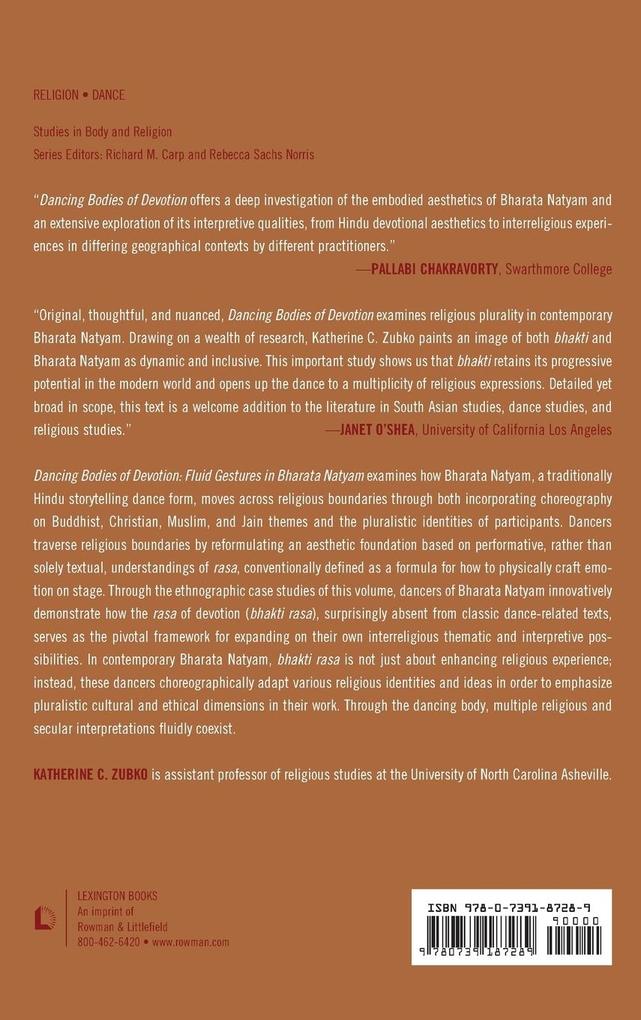
Zustellung: Do, 03.07. - Mo, 07.07.
Versand in 7 Tagen
VersandkostenfreiBestellen & in Filiale abholen:
This ethnography examines how contemporary dancers of Bharata Natyam, a traditionally Hindu storytelling dance form, embody Buddhist, Muslim, Christian and Jain narratives. These dancers choreographically adapt various religious identities and ideas in order to emphasize pluralistic cultural and ethical dimensions in their work. Through the dancing body, multiple religious and secular interpretations are able to co-exist.
Inhaltsverzeichnis
Part I: Religious Bodies
Chapter 1: Rasa: A Taste of the Divine
Chapter 2: Balasaraswati and Krishna Ni Begane Baro
Chapter 3: Francis Barboza and Christian Themes
Conclusion: Bhakti Rasa: A Re-Personalized Aesthetic of Devotion
Part II: Cultural Bodies
Chapter 4: Rasa and Bhakti as Indian Categories
Chapter 5: Dhananjayans' Sanghamitr
Chapter 6: Kalai Kaviri's G yatr Mantra
Conclusion: Is there an Indian way of dancing devotion?
Part III: Ethical Bodies
Chapter 7: N ya as Visual Education and the Ethics of Rasa
Chapter 8: Dhananjayans' Stree (Woman)
Chapter 9: Monica Cooley's Subh sitam: Morality Tales of India and Bhagavad G t abdam
Conclusion: An Ethics of Bhakti Rasa: Performance of a Moral Mood
Part IV: Pluralistic Bodies
Chapter 10: Unity and Multiplicity of Rasa
Chapter 11: Malini Srinivasan and Sufi Qaww li
Chapter 12: Tehreema Mitha and Ratt Jaga (The Vigil)
Conclusion: Revisiting "Unity in Diversity"
Conclusion
Glossary
Illustrated Glossary of Gestures
Chapter 1: Rasa: A Taste of the Divine
Chapter 2: Balasaraswati and Krishna Ni Begane Baro
Chapter 3: Francis Barboza and Christian Themes
Conclusion: Bhakti Rasa: A Re-Personalized Aesthetic of Devotion
Part II: Cultural Bodies
Chapter 4: Rasa and Bhakti as Indian Categories
Chapter 5: Dhananjayans' Sanghamitr
Chapter 6: Kalai Kaviri's G yatr Mantra
Conclusion: Is there an Indian way of dancing devotion?
Part III: Ethical Bodies
Chapter 7: N ya as Visual Education and the Ethics of Rasa
Chapter 8: Dhananjayans' Stree (Woman)
Chapter 9: Monica Cooley's Subh sitam: Morality Tales of India and Bhagavad G t abdam
Conclusion: An Ethics of Bhakti Rasa: Performance of a Moral Mood
Part IV: Pluralistic Bodies
Chapter 10: Unity and Multiplicity of Rasa
Chapter 11: Malini Srinivasan and Sufi Qaww li
Chapter 12: Tehreema Mitha and Ratt Jaga (The Vigil)
Conclusion: Revisiting "Unity in Diversity"
Conclusion
Glossary
Illustrated Glossary of Gestures
Produktdetails
Erscheinungsdatum
07. August 2014
Sprache
englisch
Seitenanzahl
270
Autor/Autorin
Katherine C. Zubko
Verlag/Hersteller
Produktart
gebunden
Gewicht
593 g
Größe (L/B/H)
235/157/21 mm
ISBN
9780739187289
Entdecken Sie mehr
Bewertungen
0 Bewertungen
Es wurden noch keine Bewertungen abgegeben. Schreiben Sie die erste Bewertung zu "Dancing Bodies of Devotion" und helfen Sie damit anderen bei der Kaufentscheidung.










